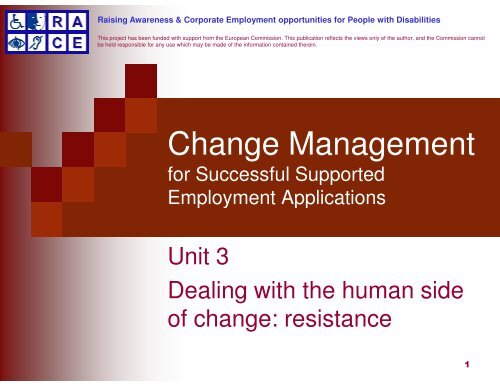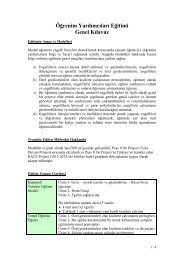Unit 3: Dealing with the human side of change - Supported ...
Unit 3: Dealing with the human side of change - Supported ...
Unit 3: Dealing with the human side of change - Supported ...
Create successful ePaper yourself
Turn your PDF publications into a flip-book with our unique Google optimized e-Paper software.
Contents – <strong>Unit</strong> 3Introduction to <strong>the</strong> unitWhy do people resist to <strong>change</strong>?What is resistance and how can you recognize it?When is a <strong>change</strong> process a resistance sensitive <strong>change</strong>process?The Kotter model: implementing <strong>change</strong> while taking intoaccount <strong>the</strong> aspects that make people commit to <strong>change</strong>Conclusions2
Learners who successfullycomplete this unit will:Recognize resistance in all its formsUnderstand why people resist to <strong>change</strong> and assess <strong>the</strong>own <strong>change</strong> project on its resistance sensitivityOrganize <strong>the</strong> own <strong>change</strong> process in a way that takesinto account <strong>the</strong> aspects (<strong>of</strong> <strong>the</strong> Kotter Model) that makepeople commit to <strong>change</strong>3
The Rational and Emotional Aspects <strong>of</strong>Change ProcessesA linear, rational process focusing on <strong>the</strong> plannedimplementation <strong>of</strong> specific <strong>change</strong>FIELD OF TENSIONBehavioural <strong>change</strong> is an emotional cyclic process4
How people express <strong>the</strong>ir feelings intimes <strong>of</strong> <strong>change</strong>performanceSHOCK & DENYINGANGERACCEPTINGtimeNEGOTIATINGEXPERIMENTINGDEPRESSION5
A typology <strong>of</strong> resistance Cultural resistance Practical resistance Psychological resistance6
A typology <strong>of</strong> resistanceCultural resistance:‘In our family, we deal <strong>with</strong> such things differently’, or‘That comes from Brussels/London doesn't it?’, or‘Something like that will never work in our organization.’An individual is part <strong>of</strong> a social network(s) <strong>with</strong> its ownnorms and values, habits and routines. He/she will lookat every <strong>change</strong> that he/she is confronted <strong>with</strong> from thisperspective.7
A typology <strong>of</strong> resistancePractical resistance:‘Will I still be able to stop working at 6 pm?’ or ‘When Ihave to do this, I will have to come to work by car?’ or‘Isn’t this causing workload to decrease?’.People will always make a personal cost-benefit-analysis<strong>of</strong> <strong>the</strong> <strong>change</strong>. Their willingness to commit to <strong>the</strong> <strong>change</strong>process will depend on <strong>the</strong> outcome <strong>of</strong> <strong>the</strong> analysis.8
A typology <strong>of</strong> resistancePsychological resistance:‘Why do you want me to <strong>change</strong>: wasn’t I doing my jobwell enough?’When you ask people to <strong>change</strong>, <strong>the</strong>y will <strong>of</strong>ten have <strong>the</strong>feeling that you disapprove <strong>of</strong> <strong>the</strong>ir current way <strong>of</strong>working. Therefore, it is important to put <strong>the</strong> new way <strong>of</strong>working next to and not above <strong>the</strong> current way.9
Means to express resistance Fighting: open, direct, active, agressiveExamples: being sarcastic, yes but – reaction, takingcontradictory actions, destroying… Escaping: hidden, indirect, passive and<strong>of</strong>ten regressiveExamples: postponing, acting helplessly, being silent,denying <strong>the</strong> problem…10
A typology <strong>of</strong> resistanceExercise 1:Think <strong>of</strong> your own <strong>change</strong> process and <strong>the</strong>people you have to work <strong>with</strong> to implementthis <strong>change</strong> process (check your notes<strong>with</strong> respect to <strong>the</strong> <strong>change</strong> curve). Wheredid you detect ‘resistance’? How was itexpressed? What may be <strong>the</strong> reason forit?11
High risk <strong>change</strong> processesSome <strong>change</strong> processes generate more resistance thano<strong>the</strong>rs:• Change processes that affect <strong>the</strong> requirements <strong>with</strong> respect toknowledge and skills• Change processes that are associated <strong>with</strong> <strong>the</strong> loss <strong>of</strong> money orstatus• Change processes that are required by o<strong>the</strong>rs/external factors• Change processes that entail a lot <strong>of</strong> risk• Change processes that disturb <strong>the</strong> current social relations‘12
High risk <strong>change</strong> processesExercise 2:Is implementing ‘supported employment’ ahigh risk <strong>change</strong> process? Explain whyand give as many examples as possible.13
Responding to resistance <strong>of</strong>individualsPatience and respectRemind people <strong>of</strong> <strong>the</strong> factsPositive confirmation <strong>of</strong> past effortsperformanceSHOCK & DENYINGANGERLet <strong>of</strong>f steamDo not enter into conflictACCEPTINGtimeNEGOTIATINGEXPERIMENTINGBe determined DEPRESSIONRealize quick winsCelebrate successAim for <strong>the</strong> futureShow empathyCoach, help people comprehend,help people think clearly14
Managing structural resistance –The Kotter ModelJohn Kotter's highly regarded books 'Leading Change' (1995) and <strong>the</strong> follow-up 'The HeartOf Change' (2002) describe a helpful model for understanding and managing <strong>change</strong>.Increase urgencyBuild <strong>the</strong> guiding teamGet <strong>the</strong> vision rightCommunicate for buy-inEmpower actionCreate short-term winsDon't let upMake <strong>change</strong> stick15
Assignment 1 Part 1: assessment <strong>of</strong> <strong>the</strong> ‘as-is’ situation <strong>with</strong>regard to <strong>the</strong> Kotter Model Which phases are already integrated? What goes well? What can be improved? Part 2: action plan for <strong>the</strong> ‘to-be’ situation Which phases need to be added? Specify concreteactions! Which actions need to be replaced? Integrate this in one action plan16
Assignment 1Phase Actions Impact onresistanceIncrease … …urgency … …Building <strong>the</strong>guiding team… … … … …17
“Performance Improvement Grid”START DOINGSTOP DOINGDO MOREDO DIFFERENTLY18
















